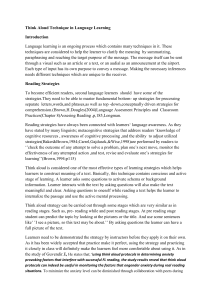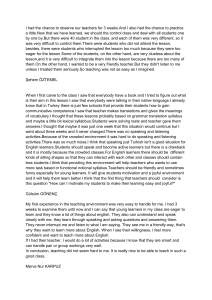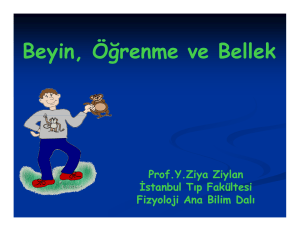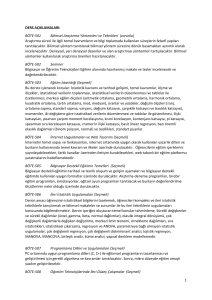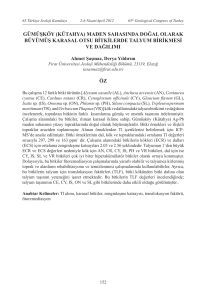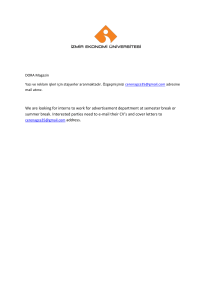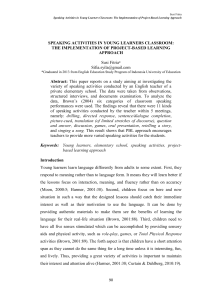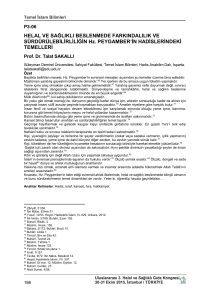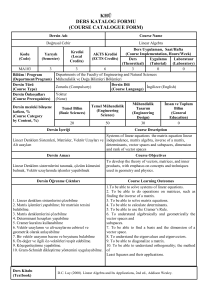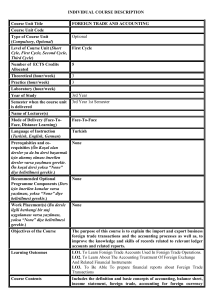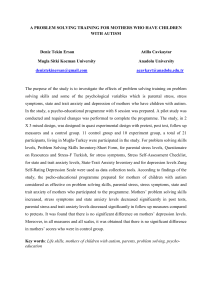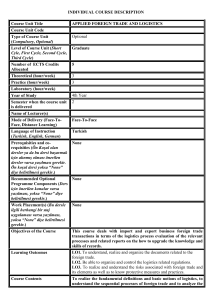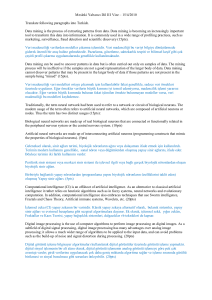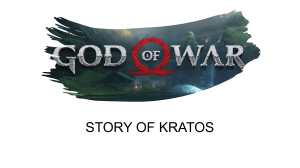learner autonomy ıssue öğrenen özerkliği konusu
advertisement
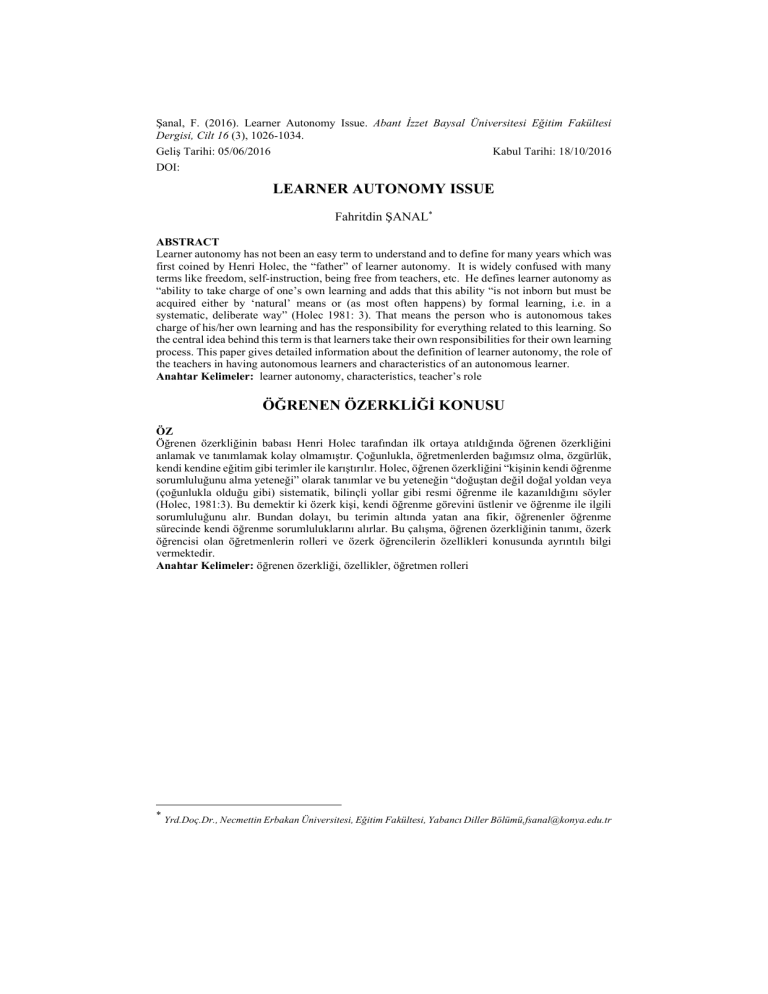
Şanal, F. (2016). Learner Autonomy Issue. Abant İzzet Baysal Üniversitesi Eğitim Fakültesi Dergisi, Cilt 16 (3), 1026-1034. Geliş Tarihi: 05/06/2016 Kabul Tarihi: 18/10/2016 DOI: LEARNER AUTONOMY ISSUE Fahritdin ŞANAL* ABSTRACT Learner autonomy has not been an easy term to understand and to define for many years which was first coined by Henri Holec, the “father” of learner autonomy. It is widely confused with many terms like freedom, self-instruction, being free from teachers, etc. He defines learner autonomy as “ability to take charge of one’s own learning and adds that this ability “is not inborn but must be acquired either by ‘natural’ means or (as most often happens) by formal learning, i.e. in a systematic, deliberate way” (Holec 1981: 3). That means the person who is autonomous takes charge of his/her own learning and has the responsibility for everything related to this learning. So the central idea behind this term is that learners take their own responsibilities for their own learning process. This paper gives detailed information about the definition of learner autonomy, the role of the teachers in having autonomous learners and characteristics of an autonomous learner. Anahtar Kelimeler: learner autonomy, characteristics, teacher’s role ÖĞRENEN ÖZERKLİĞİ KONUSU ÖZ Öğrenen özerkliğinin babası Henri Holec tarafından ilk ortaya atıldığında öğrenen özerkliğini anlamak ve tanımlamak kolay olmamıştır. Çoğunlukla, öğretmenlerden bağımsız olma, özgürlük, kendi kendine eğitim gibi terimler ile karıştırılır. Holec, öğrenen özerkliğini “kişinin kendi öğrenme sorumluluğunu alma yeteneği” olarak tanımlar ve bu yeteneğin “doğuştan değil doğal yoldan veya (çoğunlukla olduğu gibi) sistematik, bilinçli yollar gibi resmi öğrenme ile kazanıldığını söyler (Holec, 1981:3). Bu demektir ki özerk kişi, kendi öğrenme görevini üstlenir ve öğrenme ile ilgili sorumluluğunu alır. Bundan dolayı, bu terimin altında yatan ana fikir, öğrenenler öğrenme sürecinde kendi öğrenme sorumluluklarını alırlar. Bu çalışma, öğrenen özerkliğinin tanımı, özerk öğrencisi olan öğretmenlerin rolleri ve özerk öğrencilerin özellikleri konusunda ayrıntılı bilgi vermektedir. Anahtar Kelimeler: öğrenen özerkliği, özellikler, öğretmen rolleri * Yrd.Doç.Dr., Necmettin Erbakan Üniversitesi, Eğitim Fakültesi, Yabancı Diller Bölümü,[email protected] Fahritdin ŞANAL 1.INTRODUCTION There is a redoubled importance given to the learners in language teaching and learning as a consequence of the changing views in the field of second/foreign language learning (ESL/EFL). That is, they are no more passive in their learning process. Their needs, interests, learning styles, and other individual differences are being taken into account by their teachers in the learning-teaching environment. Learner autonomy is one of the key words which has come to order in English Language Teaching atmospheres over the last two decades as a result of these noticeable changes. It has been a major area of interest in teaching and learning a second language. 2. DEFINITION OF LEARNER AUTONOMY Learner autonomy has not been an easy term to understand for many years. It should be better to look at the term “autonomy” first to have a clear idea about learner autonomy. For the use of “autonomy” in language education, Benson and Voller (cited in Üğüten 2009: 3-4) recommend five different ways: 12345- for situations in which learners study entirely on their own; for a set of skills which can be learned and applied in self-directed learning; for an inborn capacity which is suppressed by institutional education; for the exercise of learners’ responsibility for their own learning; for the right of learners to determine the direction of their own learning. So what is learner autonomy? It is not an easy task to define learner autonomy which was first coined by Henri Holec, the “father” of learner autonomy. He defines learner autonomy as “ability to take charge of one’s own learning and adds that this ability “is not inborn but must be acquired either by ‘natural’ means or (as most often happens) by formal learning, i.e. in a systematic, deliberate way” (Holec 1981: 3). That is taking charge of one’s learning means having all the necessary responsibilities for everything related to this learning. So the central idea behind this term is that learners take their own responsibilities for their own learning process. They are not expected to be passive in the classroom. As Dikilitaş (2015: 47) stated “trainees are no longer seen as recipients of knowledge, but constructors of it through active engagement in the process of learning. In addition, they are given more opportunities to take control of their learning as is implied and encouraged by principles of autonomous learning”. They are the ones who should think about whole process and take the necessary decisions and responsibilities. They can use their own ideas and apply them in their own learning. If they have a place in decision making process actively, they are on the way of being autonomous (Camilleri 1997; Dam 1995; Benson 2001). Learners are very complex. It is difficult to understand what they are thinking or what they need and want. According to Barkhuizen, the L2 learners in classroom atmosphere need to: be encouraged to express their perceptions overtly, both for themselves and their teachers. Doing so would allow learners to consider why they are participating in certain activities, how these activities help them learn English, and what use they can make of them both for academic purposes and outside of the classroom.(cited in Bulut and Durak 2002: 2-3) 1027 Learner Autonomy Issue Learners do not want to be passive in the classroom settings. They are eager to be active in every step of their learning processes. If they know the reasons of their doing something, they learn better. As Little and Dam stated (1998:1): Learner autonomy is a matter of explicit or conscious intention: we cannot accept responsibility for our own learning unless we have some idea of what, why, and how we are trying to learn. The learner must take at least some of the initiatives that give shape and direction to the learning process, and must share in monitoring progress and evaluating the extent to which learning targets are achieved. The pedagogical justification for wanting to foster the development of learner autonomy rests on the claim that in formal educational contexts, reflectivity and self-awareness produce better learning. There are many definitions of learner autonomy. Sometimes it is used interchangeably with some other terms like self-directed learning, free learners, etc. However, there are of course certain differences between these terms. For instance, Reinders (cited in Üğüten, 2009: 3) states that “self-directed learning can be defined as a learner-initiated process in which the learner is the center to decide to study”. On the other hand, learner autonomy has an idea that learners take responsibilities for their own learning which does not mean that learners are isolated from their teachers and from the learning environment. This idea involves learner-centered instruction which “is not a matter of handing over rights and powers to learners in a unilateral way. Nor does it involve devaluing the teacher. Rather, it is a matter of educating learners so that they can gradually assume greater responsibility for their own learning” (Nunan 1999: 12) Learner autonomy does not mean learner isolation from the learning atmosphere. In a class, there should be independent language learning in which teachers goal is to give their learners more control over his/her learning; that is what to learn, how to learn, when to learn and why to learn. Learners should decide on their aims, their methods of learning and even they should sometimes assess themselves. According to Little and Dam (1998: 1): The ideas that cluster around the concept of learner autonomy have also been promoted under banners such as, "humanistic language teaching," "collaborative learning," "experiential learning," and "the learningcentered classroom." We prefer the term "learner autonomy" because it implies a holistic view of the learner as an individual. This seems to us important for two reasons. First, it reminds us that learners bring to the classroom a personal history and personal needs that may have little in common with the assumed background and implied needs on which the curriculum is based. Second, it reminds us that the ultimate measure of success in second or foreign language learning is the extent to which the target language becomes a fully integrated part of the learner's identity. As Little and Dam (1998) indicate, learner autonomy needs a clear and conscious goal. That is, if the learners do not have an idea about what they are doing, how they are doing and why they are doing, they do not accept the responsibility for their learning process. 1028 Fahritdin ŞANAL Sinclair (in Borg and Al-Busaidi, 2012: 5) suggests 13 aspects of learner autonomy ‘which appear to have been recognized and broadly accepted by the language teaching profession’: 1- Autonomy is a construct of capacity 2- Autonomy involves a willingness on the part of the learner to take responsibility for their own learning 3- The capacity and willingness of learners to take such responsibility is not necessarily innate 4- Complete autonomy is an idealistic goal 5- There are degrees of autonomy 6- The degrees of autonomy are unstable and variable 7- Autonomy is not simply a matter of placing learners in situations where they have to be independent 8- Developing autonomy requires conscious awareness of the learning process – i.e. conscious reflection and decision-making 9- Promoting autonomy is not simply a matter of teaching strategies 10- Autonomy can take place both inside and outside the classroom 11- Autonomy has a social as well as an individual dimension 12- The promotion of autonomy has a political as well as psychological dimension 13- Autonomy is interpreted differently by different cultures It is understood from these features that in teaching and learning process, learners’ taking responsibility is a must. At this point, the role of the teachers gains importance as they are the ones who should direct the learners. 3. TEACHERS’ ROLE IN LEARNER AUTONOMY Teachers should explain the learners that being autonomous does not mean learning without teachers. Barfield et al. (cited in Balçıkanlı, 2010: 91) indicate the importance of teachers’ role in this process since “the ability to behave autonomously for students is dependent upon their teacher creating a classroom culture where autonomy is accepted”. Camilleri states three roles of teachers in gaining autonomous learners (1997: 36-37): 1- Teacher as a resource person: The teacher optimizes learning conditions by helping learners all the available resources, strategies and learning styles. 2- Teacher as counselor: The teacher is able to accompany individual learning processes, to find solutions to the learning problems. 3- Teacher as manager: The teacher is the manager of the activities. Teachers’ role changes depending on the learning environment, the learners and their needs. Lee (cited in Koçak, 2003: 90) suggests that teachers should be flexible to teach the learners having responsibilities for the learning process as flexibility is an important factor in developing autonomy. Teachers aim is to have autonomous learners in their classes. So who is an autonomous learner? 4. THE CHARACTERISTICS OF AUTONOMOUS LEARNERS Koçak (2003: 28) defines autonomous learners as the” the ones who take active roles in the learning process, by finding more learning opportunities for themselves, rather than 1029 Learner Autonomy Issue being the complete pursuer of the teacher”. According to Dickinson ( in Koçak, 2003: 28-29), autonomous learners can be characterized in four points: 1- They can identify what is going on, in other words what has been taught in their classes. When they learn a new item, they try to have a link between the new one and the previous ones. 2- They are capable of formulating their own learning objectives, in parallel with or even in addition to their teachers. As they are ready to have the necessary responsibility for their own learning processes, they continue to improve their knowledge outside the classroom. 3- They are able to select and implement appropriate learning strategies. They do not just read or write; instead, they try to examine the task they are doing. 4- They can monitor the effectiveness of their use of strategies and make necessary changes for them. They do not directly blame the teacher or the system when they have low marks; instead he/she tries to find the problem and searches for extra ways to study. As it is understood from the characteristics, it can be said that learners are ready to take the responsibility for their own learning; that is, learners always ask some questions about their learning like what, when, why, etc. This shows that learners are critical at the same time. Breen and Mann (in Benson 2001: 84-85) suggested that autonomous learners: 1- see their relationship to what is to be learned, to how they will learn and to the resources available as one in which they are in charge or in control 2- are in an authentic relationship to the language they are learning and have a genuine desire to learn that particular language 3- have a robust sense of self that is unlikely to be undermined by any actual or assumed negative assessments of themselves or their work 4- are able to step back from what they are doing and reflect upon it in order to make decisions about what they next need to do and experience 5- are alert to change and able to change in an adaptable, resourceful and opportunistic way 6- have a capacity to learn that is independent of the educational processes in which they are engaged 7- are able to make use of the environment they find themselves in strategically 8- are able to negotiate between the strategic meeting of their own needs and responding to the needs and desires of other group members That is, they should be ready to be independent of their teachers and their friends which does not mean a complete isolation. They have the capacity to think about their own learning processes. Chan (cited in Koçak 2003: 29) also identified the following features of an autonomous learner: 1234567- highly motivated goal oriented well-organized hard-working initiative enthusiastic about learning flexible 1030 Fahritdin ŞANAL 8- active 9- willing to ask questions 10- making use of every opportunity to improve their learning To sum up, an autonomous learner has numerous features to be explained. The main point is that, when compared to traditional classrooms, they are more active in learning atmospheres. 5. CONCLUSION In today’s world, because of the need to catch high-speed changes in every part of the teaching systems, it is inevitable and fundamental to have autonomous learners for an effective language teaching. The underlying principle of learner autonomy is that learners take the responsibilities of all the stages of their own learning and behave according to it (Durak, 2015). That means, they are no more just the receptors of the information in the classrooms. They are in cooperation with their teachers and friends. As a result, they feel more confident and motivated which increases willingness and success in the classroom. REFERENCES Balçıkanlı, C. (2010). “Learner Autonomy In Language Learning: Student Teachers’ Beliefs”. Retrieved on April 8, from http://ro.ecu.edu.au/cgi/viewcontent.cgi?article=1331&context=ajte Benson, P. (2001). Teaching and researching autonomy in language learning. London: Longman. Borg, S. & Al-Busaidi, S. (2012). “Learner Autonomy: English Language Teachers’ Beliefs and Practices”. Retrieved on April 7, 2015 from https://www.teachingenglish.org.uk/sites/teacheng/files/b459%20ELTRP%20Report %20Busaidi_final.pdf Bulut, T. & Durak, S. (2002) “Student Perceptions and Language Teaching.”. 1st International Symposium on Modern Approaches, Methods, & ELT Problems, SDU, Isparta. Camilleri, G.(1997). “Learner Autonomy-The Teachers Views”. Retrieved on June 16, 2015 from http://archive.ecml.at/documents/pubCamilleriG_E.pdf Dam, L. (1995), Learner Autonomy 3: From Theory to Classroom Practice, Dublin: Authentik. Dikilitaş, K. (2015). Professional development through teacher-research. Kenan Dikilitaş (Ed). Teacher-Researchers in Action (p. 47-55). Retrieved on May, 16, 2016 from file:///C:/Users/ADNAN%20KORAY/Desktop/teacher-researchers_in_action.pdf Durak Üğüten, S. (2009). The Use of Writing Portfolio in Preparatory Writing Classes to Foster Learner Autonomy. Unpublished PhD thesis, Çukurova University, Adana Durak Üğüten, S. (2015). Ögrenen Özerklıgı (Learner Autonomy). Dıl Ögretımı, Pegem, Editor: Bekleyen, Nılüfer, Page number 504, ISBN:6053182481, (Publish No: 2176284) Holec, H. (1981). Autonomy in Language Learning, Oxford: Pergamon Koçak, A. (2003). A Study on Learners’ Readiness for Autonomous Learning of English as a Foreign Language. Unpublished Master’s thesis, METU, Ankara Little, D. & Dam, L. (1998), “Learner Autonomy: What and Why?” Retrieved on April 8, 2015 from http://www.jalt-publications.org/tlt/articles/2377-jalt98-special-guest-speakerslearner-autonomy-what-and-why Nunan, D. (1999). Second Language Teaching & Learning, Boston: Heinle & Heinle Publishers: 1031 Learner Autonomy Issue GENİŞ ÖZET Öğrenme ve öğretme sürecinde kullanılan yöntemler üzerine yıllardır sure gelen bir tartışma söz konusudur. Zaman içerisinde birçok yöntem denenmiş, artıları eksileri tartışılmıştır. Geleneksel yöntem mi yoksa öğrenci merkezli öğrenme mi daha iyidir sorusu cevaplanmaya çalışılmıştır. Geleneksel yöntem öğretmen merkezlidir. Sınıf içerisinde ve sınıf dışında gerçekleşecek öğrenme ve öğretme sürecine karar verecek kişidir. Öğretme nerede gerçekleşecek, ne öğretilecek, nasıl öğretilecek, ne zaman öğretilecek ve öğrenme ve öğretme sürecinde hangi materyaller kullanılacak sorularının hepsinin cevabı öğretmendir. Öğetmen sürekli bilgi veren, öğrenen ise sınıfta aktif olmayan ve sürekli verilen bilgiyi alan kişi durumundadır. Geleneksel yöntemin uzun yıllar tartışılan noktası öğrenciyi pasif durumda bırakmasıdır. Bu konunun eksikliğini gidermek için son yıllarda öğrencinin artık pasif rol oynamadığı, kendi öğrenme süreci ile ilgili kararlarda söz sahibi olduğu, öğretmenin öğretme sürecinin merkezinde olmak yerine bu sürece yardım eden kişi olarak görüldüğü öğrenci merkezli eğitim yöntemleri yaygınlaşmaya başlamıştır. Öğrenci merkezli yöntemlerin temel amacı tamamen öğretmenine bağımlı öğrenenlere sahip olmak yerine, kendi başına kararlar alabilen, sınıf içerisinde öğretmen ve öğrenen arkadaşlarıyla işbirliği yaparak bu sürece dahil olabilen, aldığı kararların sonuçlarına katlanabilen, kendi eksik yönlerini tarafsızca görebilen ve geliştirmek için çözümler arayan, tamamen öğretmeninden bağımsız olmak yerine birlikte hareket ederek öğrenme ve öğretme sürecini daha etkili hale getirmeye çalışan özerk öğrenenlere sahip olmaktır. Öğrenen özerkliği konusu birçok yıldır tanımlaması ve anlaması kolay olmayan, yeni bir terimdir. Uzun yıllar boyunca öğrenme ve öğretme alanlarının birçoğunda söz konusu bile olmamıştır. Ama son yıllarda her türlü öğrenme alanında olduğu gibi yabancı dil olarak ingilizce öğrenme alanında da değişen bakış açılarının sonucu olarak dil öğrenme ve öğretmede öğrenenlere artan bir önem verilmeye başlanmıştır. Bu da demektir ki, öğrenenler sınıfta pasif olarak oturan ve sadece verilen bilgiyi alan kişiler olarak görülmek yerine sürecin bir parçası olarak görülmeye başlanmıştır. Bireysel farklılıkları, ihtiyaçları, ilgileri ve öğrenme stilleri öğrenme ve öğretme sürecinde dikkate alınmaya başlanmıştır. Öğrenen özerkliği de özellikle son yıllarda kaydadeğer gelişme ve değişmelerin soucu olarak dil öğrenme ve öğretme süreçlerinde yerini almaya başlamıştır. İlk olarak öğrenen özerkliğini “ kişinin kendi öğrenme sorumluluğunu alma yeteneği” olarak tanımlayan ve bu yeteneğin “doğuştan değil doğal yoldan veya (çoğunlukla olduğu gibi) sistematik, bilinçli yollar gibi resmi öğrenme ile kazanıldığını söyleyen (Holec, 1981:3) öğrenen özerkliğinin babası Henri Holec tarafından ortaya atılmıştır. Bu demektir ki özerk kişi, kendi öğrenme görevini üstlenir ve öğrenme ile ilgili sorumluluğunu alır. Sınıf ortamında pasif şekilde oturup sadece verilen bilgiyi alan kişi olmak yerine kendi öğrenme ve öğretme süreçlerinde aktif olmaları için cesaretlendirilirler. Bundan dolayı, bu terimin altında yatan ana fikir, öğrenenlerin öğrenme sürecinde kendi öğrenme sorumluluklarını almalarıdır. Çoğunlukla özgürlük, öz talimat, öğretmenden bağımsız olma vb terimlerle karıştırılır. Geleneksel yöntemden vazgeçmek ve yeni yöntemleri benimsemek her zaman ve her alanda zor olduğu gibi öğrenme ve öğretme sürecinde de bu geçiş çok da kolay olmamıştır. Bu sebeple, öğretmen rolleri de geleneksel yöntemle karşılaştırıldığında tamamen değişeceği için de öğrenen özekliğini anlama sürecinde öğretmenlere de önemli görevler düşmektedir. 1032 Fahritdin ŞANAL Öğrenenlere süreçte bağımsız olmanın öğretmenden kopmak olmadığını, süreci ve süreçte gerçekleşecek problemlerin sorumluluklarını birlikte alacaklarını açıklamaları sürecin kolaylaşması bakımından önemlidir. Eğer öğrenen özerkse, bu öğretmeninden hiçbir dönüt almayacağı anlamına gelmez. Sınıfta, öğretmenin öğrenenlere daha fazla kontrol vermeyi hedeflediği özgür dil öğrenme ortamları olmalıdır. Yani, ne öğrenilecek, nerede öğrenilecek, nasıl öğrenilecek, ne zaman öğrenilecek ve öğrenme ve öğretme sürecinde ne gibi materyaller kullanılacağı gibi konularda öğrenen de söz sahibi olmalıdır. Hatta her ne kadar değerlendirme süreçlerine öğrenenleri de dahil etme fikri başlarda de öğretmenleri korkutsa da öğrenenlerin de bu sürecin içerisinde olmaları ve kendi değerlendirmelerinin sorumluluğunu almaları, özerk öğrenenlere sahip olmak yolunda atılması gereken önemli adımlardan birisidir. Öğretmenler öğrenenlere, özerk olmanın öğretmensiz öğrenme anlamına gelmediğini, değerlendirme sürecine dahil olmalarının kendileri için faydalı bir süreç olduğunu açıklamalıdırlar. Barfield ve arkadaşlarının da belirttiği gibi bu süreçte “özerkliğin kabul edildiği sınıf kültürü yaratan öğretmenlerine bağımlı öğrenenlerin özerk bir şekilde davranma yeteneği” nden dolayı öğretmenin rolü önemlidir (akt. Balçıkanlı, 2010: 91). Bu da özerk öğrenenlere sahip olma da öğretmenin rolünün önemini açıklamaktadır. Camilleri özerk öğrenen edinme sürecinde öğretmenin üç önemli görevini vurgulamaktadır (1997: 36-37): İdareci olarak öğretmen (Teacher as a manager): Öğretmen aktivitelerin idarecisidir. Kaynak kişi olarak öğretmen (Teacher as a resource person): Öğretmenler öğrenme koşullarını öğrenenler için daha uygun ve verimli hale getirirler. Örneğin herhangi bir aktiviteyi direk alıp uygulamak yerine öğrenenlerin ilgi ve ihtiyaçlarına göre düzenler. Rehber olarak öğretmen (Teacher as a counselor): Öğretmen öğrenme problemlerine çözüm bulmak için kişisel öğrenme süreçlerine eşlik edebilmelidir. Sonuç olarak öğretmenin rolü öğrenme ortamına, öğrenenlerin ilgi ve ihtiyaçlarına gore şekillenmektedir. Eğer amaç özerk öğrenenlere sahip olmaksa “özerk öğrenenin özelliklerini” netleştirmek gerekir. Koçak (2003; 28) e gore özerk öğrenen “ öğretmenin tamamen takipçisi olmak yerine kendileri için daha fazla öğrenme fırsatı bulmak için öğrenme sürecinde aktif olan kişidir”. Özerk öğrenen aynı zmanda eleştirel kişidir. Kendi öğrenme sürecinin sorumluluğunu alırken ne, ne zaman, nerede, need vb sorularında cevabını arar. Öğretmenlerinden ve arkadaşlarından bağımsız olmalıdırlar. Çünkü kendi öğrenme süreçleri için doğru kararı verecek kapasiteleri vardır ve öğrenenlerin de bu kapasitelerinin farkına varmaları gerekmektedir. Chan (akt Koçak 2003; 29), özerk öğrenenin özelliklerini şöyle belirtmiştir: -Yüksek motivasyonlu -Hedef odaklı -Iyi organize olmuş -Çalışkan -Girişimci -Öğrenmeye hevesli -Esnek 1033 Learner Autonomy Issue -Aktif -Soru sormaya istekli -Öğrenmesini geliştirmek için her fırsatı kullanır Özetlemek gerekirse, özerk öğrenen birçok özelliğe sahiptir. Burada önemli olan, öğrenenlerin geleneksel öğrenme yöntemleriyle kıyaslandığında özerk öğrenme ortamında daha aktif ve istekli olduklarıdır. Geleneksel yöntemden vazgeçip özerk öğrenene sahip olma fikrini kabul etmek çok da kolay olmamıştır. Sonuçta öğretmen egemen bir eğitim siteminden öğretmenin ve öğrenenin rolünün tamamen değişeceği bir eğitim sistemine geçilmektedir. Tabii ki öğrenen merkezli yöntemlerin de tartışıla gelen pozitif ve negative yönleri bulunmaktadır. Aama genel olarak bakıldığında ve geleneksel yöntemlerle kıyaslandığında öğrenen merkezli öğrenme ve öğretme sürecine dahil olan öğrenenlerin, geleneksel yönteme dahil olan öğrenenlere gore öz güvenlerinin daha fazla olduğu, gerek özel hayatlarında gerekse eğitim öğretim hayatlarında herhangi bir problemle karşılaştıklarında öğretmenlerine ya da başka bir bireye bağımlı olmak yerine bu sürecin sorumluluğunu alarak çözümler üretmeye çalıştıkları, kendi öğrenme süreçleriyle ilgili sorumluluğu öğretmene yüklemek yerine süreci paylaşmanın kendileri için daha yararlı olduğunu, bunun öğretmenden tamamen bağımsız olmak demek olmadığını kavradıkları görülmüştür. Bu çalışmada öğrenen özerkliği konusu kısaca tanımlanmaya çalışılmış, özerk öğrenene sahip olma sürecinde öğretmenin ve öğrenenin nasıl rollere sahip olacakları hakkında ayrıntılı bilgi verilmiştir. Kuramsal bir çalışmadır. 1034
